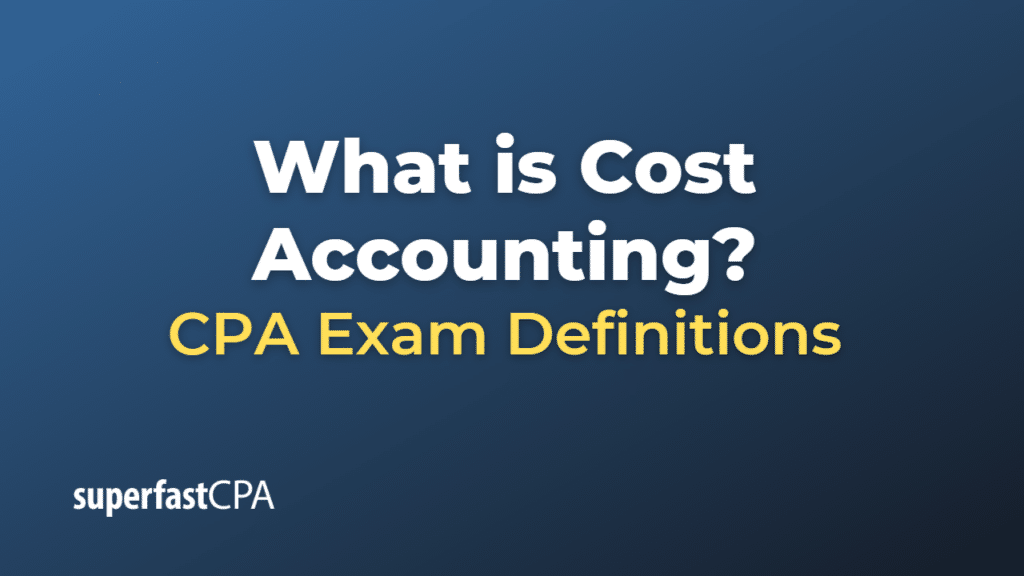Cost Accounting
Cost accounting is a specialized branch of accounting that focuses on identifying, measuring, and analyzing the costs associated with an organization’s production, operations, or projects. The primary objective of cost accounting is to help the organization manage its costs effectively, make informed financial decisions, and improve profitability and efficiency.
Cost accounting involves the following key activities:
- Cost collection and analysis: Gathering and examining cost information related to materials, labor, overhead, and other expenses to determine the cost structure of products, services, or projects.
- Cost allocation: Allocating indirect costs, such as overhead costs, to different cost centers, departments, or products using appropriate allocation methods. This helps to determine the total cost of a product or service and supports decision-making, pricing, and performance evaluation.
- Inventory valuation and management: Monitoring and managing inventory levels, performing periodic inventory counts, and calculating the value of inventory using appropriate costing methods, such as FIFO, LIFO, or weighted-average cost.
- Budgeting and forecasting: Assisting in the preparation of budgets and forecasts by estimating future costs based on historical data, trends, and management input. Cost accounting helps to compare actual costs against budgeted figures and provides variance analysis to support decision-making.
- Pricing analysis: Analyzing costs and profit margins to support pricing decisions and ensure products and services are priced competitively and contribute to overall profitability.
- Cost control and reduction: Identifying opportunities for cost reduction and efficiency improvements by analyzing cost data and working with management to implement cost-saving initiatives.
- Financial reporting: Preparing periodic cost reports and financial analyses to support management decision-making and financial reporting.
- Compliance and internal controls: Ensuring compliance with relevant accounting standards, regulations, and internal policies related to cost accounting and maintaining a strong system of internal controls to safeguard company assets.
Cost accounting is essential for organizations to make informed decisions, manage resources effectively, and maintain profitability. Cost accountants play a crucial role in this process, focusing on identifying, measuring, and analyzing costs to support management decision-making, budgeting, and cost control. Cost accounting can be applied across various industries, including manufacturing, construction, healthcare, retail, and service sectors, among others.
Example of Cost Accounting
Let’s consider an example of cost accounting at a bicycle manufacturing company called “SpeedyBikes Inc.” that produces a range of bicycles for different consumer segments.
To manage its costs effectively and make informed financial decisions, SpeedyBikes Inc. implements various cost accounting activities:
- Cost collection and analysis: The cost accounting team at SpeedyBikes Inc. gathers and examines cost information related to raw materials (e.g., metal frames, tires, gears), labor (e.g., assembly line workers, quality control staff), and overhead expenses (e.g., factory rent, utilities, machinery maintenance). This analysis helps determine the cost structure of each bicycle model and identify potential cost inefficiencies.
- Cost allocation: SpeedyBikes Inc. allocates indirect costs, such as factory rent and utilities, to different bicycle models using appropriate allocation methods. This helps the company determine the total cost of producing each bicycle model and supports decision-making, pricing, and performance evaluation.
- Inventory valuation and management: The cost accounting team monitors and manages inventory levels of raw materials, work-in-progress, and finished goods. They conduct periodic inventory counts and calculate the value of inventory using the FIFO (first-in, first-out) costing method.
- Budgeting and forecasting: The cost accounting team assists in the preparation of annual budgets and quarterly forecasts by estimating future production costs based on historical data, current trends, and input from management. They also compare actual costs against budgeted figures and provide variance analysis to support decision-making.
- Pricing analysis: The cost accounting team analyzes the costs and profit margins of each bicycle model to support pricing decisions, ensuring that the bicycles are priced competitively and contribute to the company’s overall profitability.
- Cost control and reduction: SpeedyBikes Inc. identifies opportunities for cost reduction by analyzing production processes and working with the operations team to implement cost-saving initiatives, such as negotiating better prices with suppliers or improving production efficiency.
- Financial reporting: The cost accounting team prepares periodic cost reports, such as product cost analysis and gross margin analysis, to support management decision-making and financial reporting.
- Compliance and internal controls: The cost accounting team ensures that SpeedyBikes Inc.’s cost accounting practices comply with relevant accounting standards and regulations and maintains a robust system of internal controls to safeguard company assets.
In this example, cost accounting plays a vital role in managing costs, supporting decision-making, and contributing to the overall profitability and success of SpeedyBikes Inc. By implementing cost accounting activities, the company can make informed decisions about resource allocation, pricing, and cost control to maintain its competitiveness in the market.













